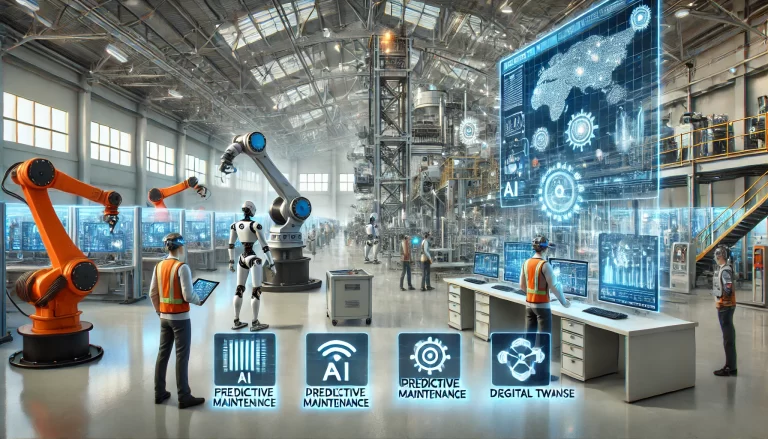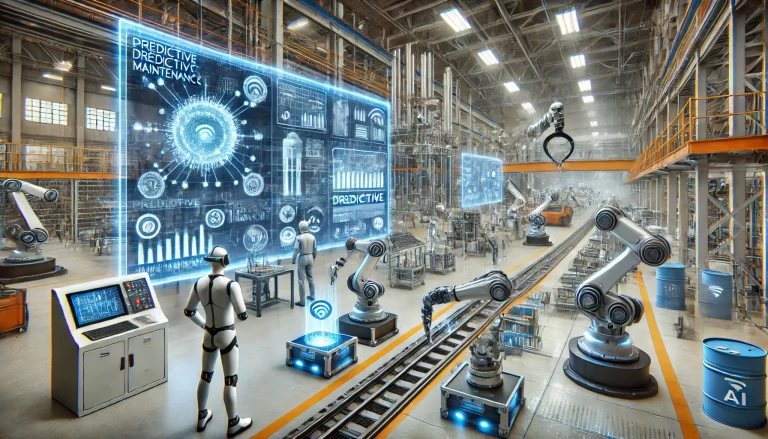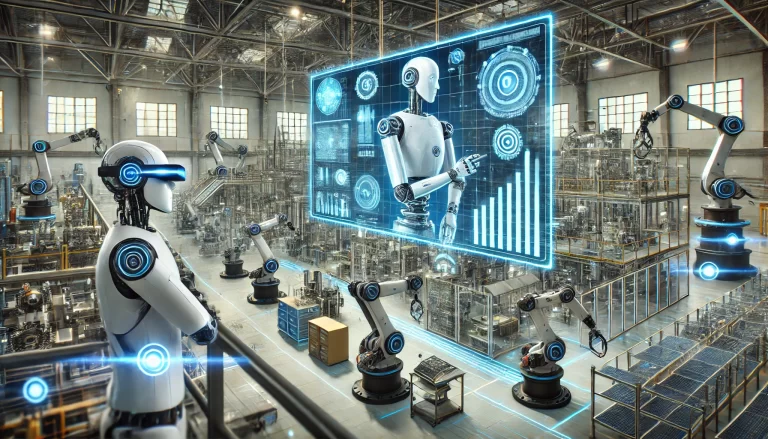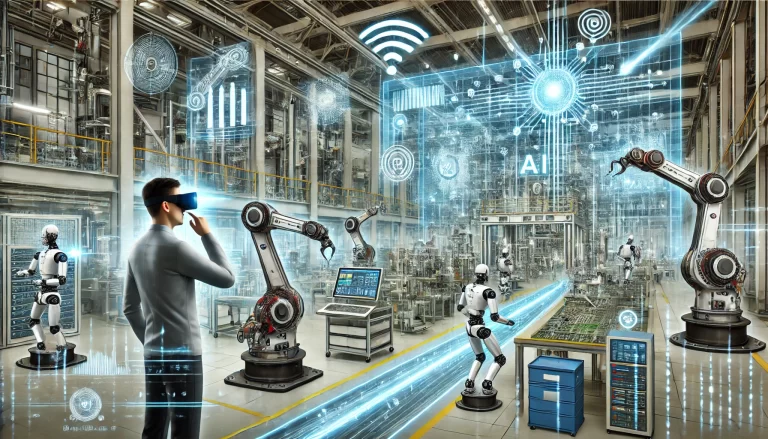The future of factories is undergoing a profound transformation, driven by the power of artificial intelligence (AI). As technology advances, AI is becoming the central engine behind factory automation, fundamentally reshaping how goods are designed, produced, and delivered. In this article, we will explore in detail the trends shaping the future of factory automation, from predictive maintenance to the rise of collaborative robots, and how these innovations are revolutionizing manufacturing.
1. Smart Manufacturing and Predictive Maintenance
One of the most significant applications of AI in future factories is predictive maintenance. Traditional maintenance approaches rely on scheduled checks or reactive responses when equipment fails, leading to costly downtime and interruptions in production. AI changes this by analyzing data from sensors embedded in machines to predict when maintenance is needed.
These AI-driven systems continuously monitor parameters such as temperature, vibration, and power consumption, learning patterns over time. When the system detects anomalies, it can predict when a failure might occur, allowing factories to schedule maintenance before a breakdown happens. This predictive capability increases equipment longevity, reduces downtime, and lowers maintenance costs.
Furthermore, AI algorithms can optimize maintenance schedules, balancing the need for timely repairs with production requirements, ensuring minimal disruption. Predictive maintenance not only enhances operational efficiency but also provides a strategic advantage in minimizing operational risks.

2. Autonomous Decision-Making and Process Optimization
AI is evolving from a mere data processing tool to a sophisticated decision-making engine capable of optimizing production processes in real-time. In future factories, AI systems will analyze data from multiple sources—machines, sensors, supply chains, and even external market conditions—to make autonomous decisions.
For instance, AI could adjust the speed of production lines, regulate material supply, and even alter energy consumption based on the current workload. This ability to optimize processes continuously allows factories to operate at peak efficiency, reducing waste and maximizing output.
Additionally, AI’s decision-making extends beyond the factory floor. AI-powered systems can analyze broader market data, such as fluctuations in demand or supply chain disruptions, enabling factories to adapt quickly to changing circumstances. This adaptive capacity ensures that factories remain agile and responsive in a dynamic global market.
3. Machine Learning and Quality Control
Ensuring product quality is critical in any manufacturing process, and AI-driven machine learning is transforming quality control. Traditional quality control methods often rely on manual inspection or simple rule-based systems, which can miss subtle defects or patterns of deviation.
AI systems, on the other hand, use machine learning algorithms to analyze vast amounts of production data, identifying patterns that indicate potential defects. These systems can detect even minute anomalies that human inspectors might overlook, ensuring a higher level of quality consistency.
Moreover, AI enables real-time quality monitoring. Instead of performing checks at fixed intervals, AI systems continuously monitor the production process, flagging potential issues as soon as they arise. This real-time feedback loop allows for immediate adjustments, reducing waste and preventing defective products from reaching customers.

4. Collaborative Robots (Cobots)
A hallmark of the future factory is the rise of collaborative robots, or “cobots.” Unlike traditional industrial robots, which often operate in isolated, fixed roles, cobots are designed to work alongside human workers, adapting to dynamic environments and learning from interactions.
AI plays a crucial role in enabling cobots to function efficiently. Through machine learning, cobots can be trained to perform complex tasks, such as assembly or quality inspection, alongside human operators. These robots can learn from their environment and from humans, improving over time and adapting to new tasks without the need for extensive reprogramming.
Cobots increase flexibility on the production line, making it easier for manufacturers to switch between different product models or accommodate custom orders. By sharing the workload between human operators and cobots, factories can enhance productivity, reduce the strain on human workers, and maintain safety standards.
5. Digital Twin Technology
Digital twins are virtual representations of physical assets, processes, or systems. By creating a digital twin of an entire factory, manufacturers can simulate production scenarios, monitor real-time operations, and test process optimizations without disrupting actual production.
AI-driven digital twins integrate data from sensors, machines, and other systems, providing a comprehensive view of the factory’s performance. This technology allows engineers and managers to predict the outcome of various scenarios, such as changes in production speed, new material use, or equipment modifications.
For example, before implementing a new manufacturing process, AI-driven digital twins can simulate the effects on production, enabling engineers to optimize the process for maximum efficiency. This capability reduces risk, speeds up innovation, and allows manufacturers to explore new methods without costly trial-and-error approaches on the actual production floor.
6. Flexible Manufacturing and Mass Customization
As consumers increasingly demand personalized products, future factories must be agile enough to handle small batch sizes and highly customized orders. AI-powered automation enables flexible manufacturing systems that can quickly adapt to changes in product design or production requirements.
With AI, production lines can be reconfigured on the fly. Robots, cobots, and automated machinery can adjust their tasks to accommodate new designs, materials, or configurations. This flexibility allows manufacturers to offer mass customization—producing individualized products at a large scale without sacrificing efficiency.
Furthermore, AI systems can optimize the supply chain to support this flexibility. By analyzing customer demand patterns, AI can adjust raw material orders, production schedules, and distribution plans to ensure that customization does not result in delays or increased costs.

7. Autonomous Supply Chain Management
AI is not limited to the factory floor; it also plays a pivotal role in managing supply chains. In an AI-driven factory, the supply chain becomes more autonomous, with AI systems predicting demand, managing inventory, and coordinating logistics in real time.
By analyzing market trends, historical data, and real-time inputs, AI can forecast demand more accurately, ensuring that factories are stocked with the right materials at the right time. This predictive capability helps avoid both overstocking and stockouts, which can lead to inefficiencies or lost sales.
Additionally, AI-driven systems can optimize logistics, determining the most efficient routes and schedules for delivering products. Autonomous vehicles and drones, also powered by AI, could further streamline transportation, reducing lead times and costs.
8. Green and Sustainable Manufacturing
Sustainability is a growing priority in modern manufacturing, and AI is helping to create greener, more energy-efficient factories. AI systems can monitor energy consumption across the factory, identifying inefficiencies and optimizing processes to reduce waste.
For instance, AI can dynamically adjust energy usage based on real-time production needs, turning off idle equipment or shifting production to times when renewable energy sources, such as solar or wind, are most available. This intelligent energy management minimizes the factory’s carbon footprint while maintaining operational efficiency.
Moreover, AI can help manufacturers comply with environmental regulations by tracking emissions, waste, and resource usage. By providing insights into how to reduce environmental impact, AI empowers manufacturers to achieve their sustainability goals while remaining competitive.
9. 5G and IoT Integration
The rollout of 5G networks will have a transformative impact on factory automation. 5G enables faster, more reliable communication between machines, sensors, and AI systems, facilitating the integration of the Internet of Things (IoT) in manufacturing.
AI-driven IoT systems will collect and analyze data from thousands of connected devices in real time, providing a comprehensive view of factory operations. This connectivity allows for instant feedback loops, where AI can make real-time adjustments to production processes based on the latest data from sensors and machines.
For example, AI can use IoT data to adjust machine settings, reorder supplies, or trigger maintenance, all without human intervention. This level of automation and responsiveness creates a highly efficient, interconnected production environment.

10. AR and VR Applications
AI-enhanced Augmented Reality (AR) and Virtual Reality (VR) technologies are becoming integral to future factories. These immersive technologies offer new ways to train workers, troubleshoot equipment, and visualize production processes.
AR allows workers to overlay digital information onto the physical world. For instance, maintenance technicians can use AR glasses to see step-by-step repair instructions or view real-time performance data while working on a machine. AI systems can analyze this data, providing insights or alerts to assist the technician in making informed decisions.
VR, on the other hand, enables virtual training and simulation. Workers can train in a virtual factory environment, learning how to operate complex machinery or respond to emergency scenarios without the risks or costs associated with real-world training.
Conclusion
The future of factory automation, driven by AI, is a vision of smart, efficient, and flexible manufacturing. From predictive maintenance to autonomous decision-making and digital twins, AI is revolutionizing how factories operate. The integration of AI with other advanced technologies like 5G, IoT, and AR/VR is creating a new era of manufacturing where adaptability, sustainability, and customization are at the forefront. Factories of the future will not only be more productive but also more intelligent, paving the way for a new industrial revolution.
